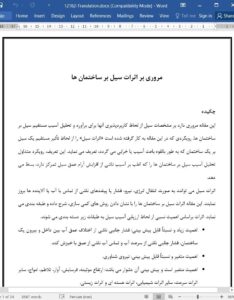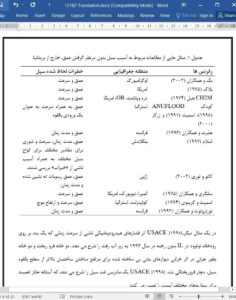Abstract
This paper presents an overview of flood characteristics with respect to their applicability for estimating and analysing direct flood damage to buildings. The approach taken is to define “flood actions” as acts which a flood could directly do to a building, potentially causing damage or failure. This definition expands the traditional approach of analysing flood damage to buildings which often focuses on damage from slow-rise flood depth.
Flood actions may be energy transfers, forces, pressures, or the consequences of water or contaminant contact. This paper defines and categorises flood actions on buildings, indicating methods of quantification. The actions are classified in the following categories with respect to relative importance for flood damage assessment.
• High relevance and relatively predictable: Lateral pressure from water depth differential between the inside and outside of a building, lateral pressure from water velocity, and water contact due to slow-rise depth.
• Relevance varies and relatively predictable: Buoyancy.
• Relevance varies and difficult predictability: Capillary rise, erosion, debris, turbulence, waves, other velocity actions, other chemical actions, nuclear actions, and biological actions.
Due to the highly localised effects of some of the flood actions in the third category, coupled with their potentially significant impact, prediction of their impact on overall flood damage may be challenging. Awareness of their existence assists in developing an understanding of the uncertainties in flood damage estimation and analysis and in indicating areas which new research should tackle. In particular, work is needed in order to fully understand the physical processes by which flood damage arises and, hence, how flood damage may be prevented.
1. Introduction
Analyses of direct flood damage to buildings often focus on damage from water contact. Water depth in slow-rise floods tends to be the flood characteristic most frequently analysed in detail. Some arbitrary choices of duration are sometimes considered too. This paper summarises flood characteristics less commonly examined in detail with respect to their applicability for estimating and analysing direct flood damage to buildings. Indirect flood damage—such as business interruption, days lost from work, and changed spending patterns—is not classified but would be an important subject for further work.
5. Conclusions
The specific extent to which flood actions other than slow-rise depth affect direct flood damage has not been considered to the level of detail afforded to slow-rise flood depth. Nonetheless, strong recognition exists of the importance which the other flood actions play in flood damage to buildings. Due to the highly localised effects of some of the flood actions, coupled with their potentially significant impact, prediction is challenging. Awareness of their existence assists in developing an understanding of the uncertainties in flood damage analysis and in indicating areas which new research should tackle.
This paper has provided an overview identifying and categorising flood actions in order to suggest their relative importance for direct flood damage assessment. These categories indicate the current capability available for introducing more flood actions to flood damage analysis. A poor capability for considering the flood actions over a relatively large space scale does not necessarily imply low impact where they do manifest. Therefore, more work is needed in order to fully understand how flood damage arises and, hence, how flood damage may be prevented.











